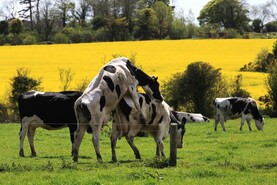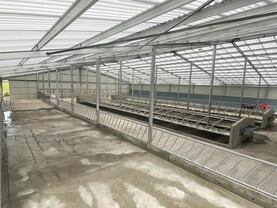An outdated, smaller cubicle house was knocked to make way for the new shed. But, because of its usefulness, a handling chute that was outside the old shed has been incorporated – in the centre of the new shed.
The shed is on the farm of Sean and Betty Culligan at Killimer in Co Clare. The Culligans built the new shed because they are increasing cow numbers, after acquiring additional land. As a result, new slurry storage was required. Until now slurry storage in the yard included an open pit.
“The open slurry store was fine in its day,” said Sean.
“It’s not so bad if it’s deep but around here most are shallow so as a result they need to be big in area. So they’re designed for catching rain and that means more work at spreading time.’’
The new shed was put up by Cooraclare farm building contractor Declan Fennel who does ground work, manufactures slats and fabricates and erects steelwork.
Picture one
The shed is seven bays long and the roof spans 18m (60ft). Behind the shed is an existing silage pit. Five bays have been fitted out with 54 Teemore cubicles. Sean has applied to the TAMS 1 scheme for grant aid on a new milking machine and bulk tank. “The jury’s still out.’’ If he is successful, his plan is to install the new milking set-up in the final two of the seven bays. The existing milking machine is a six-unit Dairymaster installed in 1979.
The shed has a slatted tank behind the feed face joining one at the near end running across the gable of the shed. Outside, there is a good wide working area in front of the shed. Eventually, this can be concreted. However, this ground was built up by up to 4ft so Sean will leave the material to consolidate. He had suitable stone material on hand to raise this ground.
Picture two
At the back of the shed is the existing silage pit. Further along, the pit wall is incorporated into the shed, with vented sheeting above it. Airflow into the shed from this side is not hindered. The roof has a ridge opening with canopy.
Picture three
Inside, the shed has a double row of cubicles, then the central handling chute, on its far side a single row of cubicles, then the standing area and feed rail. On the right, we can see how the shed shares the wall of the silage pit. The passage is cleaned by an automatic scraper.
There was an old cubicle house here. There was a double row of cubicles and the handling chute was against its outside wall. The three-legged cubicles were corroded and outdated. “The cows are very comfortable in the new cubicles,’’ Sean said.
Picture four
Behind the feed face is a 12ft 6in slat. There is no scraper here. “I could run one over the slats if I’m not happy with how clean the cows are. It would keep them cleaner. I know people who have a scraper in this position and they are very happy. My unit can run up to six passages – I would just need the scraper and rail.’’ This would not be grant aided under TAMS and would cost up to €2,000.
The feed rail has Jourdain locking barriers. “These reduce labour requirement when dosing. You have all the heads out and can let them back one at a time. The disadvantage is they cost about €150 more per bay, about €1,000 on this shed, and they allow one cow less per bay to feed.’’
Picture five
The handling chute was against the outside wall of the old cubicle shed – it’s the wall on the right. The wall on the left is a new block wall. Alongside the chute is a raised catwalk.
Picture six
The chute has gates at either end.
Picture seven
“The chute is working well in its central location,’’ Sean said. “I can run all cows from one side through it and back out to where they were.’’
Picture eight
Sean and Betty Culligan have three children: Niall, Diarmuid (pictured) and Liam. Their shed was finished on 2 December and the cows went into it that evening. “I’m very happy with the shed. The side of the feed passage is fully open and the roof is high – so it all makes the shed very airy, not stuffy. Anytime you go in you smell just fresh air.’’
Knocking the old cubicle house and building the new one cost the Culligans €84,000.
“We hadn’t done any building in a long time. I think it’s been a good investment.’’






 This is a subscriber-only article
This is a subscriber-only article

















SHARING OPTIONS: